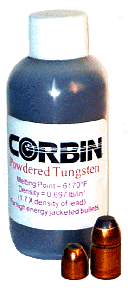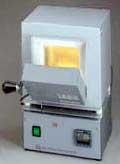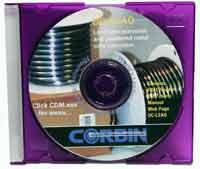Corbin provides hydrogen-reduced 99.9% purity tungsten powder in 7,000 and 70,000 grain flasks, for use as core material in high energy density bullets. A 1% accra-wax component is vapor deposited on the fine flour-like tungsten grains, which helps it flow without bridging and packs together firmly with moderate pressures. The thin film coating also aids in binding the material when it is heated to form a more solid mass (sintered). Corbin HTO-2 Heat Treatment Ovens can be used to apply a digitally-monitored high temperature evenly to groups of swaged tungsten bullets to sinter the powder grains into stronger bullet, which becomes more dense upon cooling.


The material can be poured, metered, or dipped into bullet jackets, and swaged into a non-toxic core that is heavier than lead of the same volume. The effective density of the EZ-Flow Tungsten powder depends on the pressure applied, but ranges from 1.1 to 1.4 times the density of solid lead and up to 1.7 times the density of powdered lead. The Corbin software program "DC-LEAD" includes compression versus effective density for powder metals, and makes it easy to calculate the bullet weight, density, and other factors for mixtures of metals.
Normal weight bullets can be made shorter, or the same length bullet required for good feeding in an autoloader can now be made heavier (with the proper powder type and charge, of course). In addition, the bullet maker can experiment with shifting the center of gravity (balance point) of any bullet by using a combination of lead and tungsten powder. A small amount of tungsten in a hollow point cavity will shift the balance forward, reducing the need for as fast a twist rate to maintain accuracy. A small amount of tungsten in the base area shifts the balance backward, which decreases stability and may help prevent the "over-stabilized" long range bullet that tends to maintain the same angle (attitude) at which it was launched.
Such experiments can also be done using Corbin's "Bullet Balls" (linear polyethylene spheres in various sizes and colors, which reduce the bullet weight for higher velocity without changing the length). Combinations of the polymer balls and tungsten powder can create extreme shifts of balance, or allow extremely light yet long bullets by placing the heavy material toward the tip and the light plastic toward the rear, good for short range bullet accuracy with extremely high velocity (using appropriate charge of fast burning powder). Corbin also offers powder funnel systems to match specific jacket wall thicknesses, for stacking a column of loose powder taller than the jacket and then compressing it into the jacket easily with a special, long punch, and atomized copper to shift the bullet weight in the other direction for longer bullets in a specific weight.
Corbin also offers powder funnel systems to match specific jacket wall thicknesses, for stacking a column of loose powder taller than the jacket and then compressing it into the jacket easily with a special, long punch, and atomized copper to shift the bullet weight in the other direction for longer bullets in a specific weight.
Tungsten is a stable, non-toxic material with a melting point of 3410-degrees C. and a specific gravity of 19.3 (water = 1). It is called "Wolfram" in German, and has the chemical symbol of "W". You can download the Material Safety Data Sheet in Adobe Acrobat PDF format by selecting the highlighted words in this sentence (save it to disk). The 7,000 grain flask holds 2 ounces of water; the 70,000 grain flask holds a pint of water, bearing witness to the extreme density of high purity tungsten powder in the 30 micron particle range. The 7,000 grain flask will make approximately 70 jacketed 150 grain bullets, assuming the jacket weighs about 50 grains (typical). The 70,000 grain flask makes approximately 700 150 grain bullets.
| CALIBER | WEIGHT(GR) | CORE WT | QTY/7000 | QTY/70,000 |
| .224 | 55 | 40 | 175 | 1,750 |
| .243 | 80 | 60 | 116 | 1,166 |
| .264 | 100 | 75 | 93 | 933 |
| .308 | 180 | 130 | 53 | 538 |
| .429 | 240 | 200 | 35 | 350 |
Start writing here...
About Corbin Tungsten Powder